
Coming soon
Coming soon
Select type
“Art Rotterdam will be a total experience,” says fair director Fons Hof about the first edition of the fair at Ahoy. Naturally, this includes a culinary experience. Café Marseille, a well-known name in Rotterdam, is bringing the charm of southern French cuisine to the event. We spoke with chef Derk Jan Wooldrik about the restaurant & apéro bar that will be opening its doors during Art Rotterdam.

“We are a cheeky, slightly sexy restaurant with a multicultural menu,” says Derk Jan Wooldrik, describing his restaurant. Wooldrik began his career as a ship’s cook, sailing around the world for several years before working on land. He is now co-owner of the Rotterdam restaurant Café Marseille. Together with Kristian de Leeuw, he also owns the Double Trouble Hospitality Group, which includes Bar Bilbao, Bar Alaska and Eurobrouwers. Wooldrik and De Leeuw wanted to transform the atmosphere of their restaurant on Kruiskade into a pop-up version at the fair.
They enlisted set designer and decorator Ben Zuydwijk to create the design. Zuydwijk made his name in the film industry and has won two Golden Calf awards, the latest for Hardcore Never Dies (2023). “We worked with him in the past on a Basque pop-up restaurant at Station Bergweg, where he designed a Basque punk bar called Bar Bilbao. He has a unique perspective and is a fast thinker,” says Wooldrik.
A set designer creating a restaurant may not be the most obvious choice, but considering Wooldrik’s cookbook, it makes sense. Both think in terms of experience, atmosphere and storytelling. In the foreword, Wooldrik describes himself as a rudderless ship’s cook, an adventurer without a compass. “We are storytellers. We feel at home at life’s crossroads, where trade thrives, nationalities clash and collaborate, different languages are spoken and all kinds of scents and flavours come together in a feast for the soul.” He paints a picture of these places in vivid detail: “We are in the dark alleyways of Marseille, the smoky bars of Mumbai, the sweltering streets of Havana and the docks of Rotterdam.”
Wooldrik’s dishes are based partly on memories of the port cities where he once set foot and the food he ate there. Like in Palermo, Havana and Marseille, they are created with the everyday ingredients that are available: onions, tubers, turnips, whiting and bycatch. He prefers to use no more than three or four ingredients in each dish. At the heart of every dish are Wooldrik’s famous sauces, condiments and spice blends. At Art Rotterdam, Café Marseille will be serving bouillabaisse (fish soup), braised beef chuck, sardines and lobster, among other dishes.
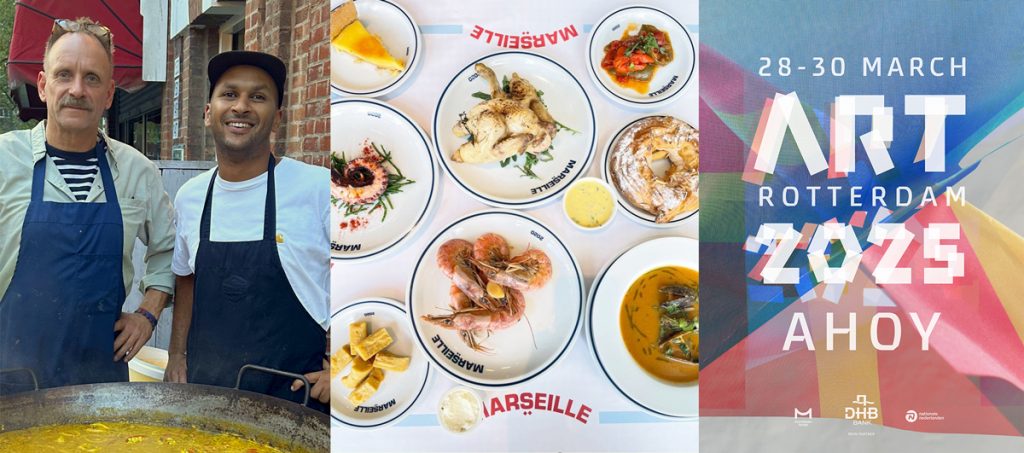
Opening hours | Reservations not possible
| Thursday March 27(opening day, invitees only) | 11.00 – 21:00 hrs |
| Friday March 28 – Sunday March 30 | 11.00 – 19:00 hrs |
Also available at the pop-up restaurant: Café Marseille: Harbor Cookbook, Het havenkookboek van een stuurloze scheepskok (The harbor cookbook of a rudderless ship’s cook). This is not a cookbook as you know it. Alongside Wooldrik’s best dishes, it is a chronicle of his cooking adventures as a ship’s cook, a journey through eight port cities where he continually lost—and found—himself in a maze of ingredients, scents and memories.
Written by Wouter van den Eijkel
Christian Holze’s work (b. 1988, Germany) exists in a space where painting, sculpture, and digital media merge into one another. Represented by Reiter Gallery, he presents Nothing New (2024) at Art Rotterdam’s Sculpture Park, a sculptural intervention that digs into the mechanics of copying, ownership, and authenticity, questioning what it really means to “own” an image or an artwork.
Christian is interested in the spaces between things, between art and commerce, between original and copy, between the seen and the unseen.
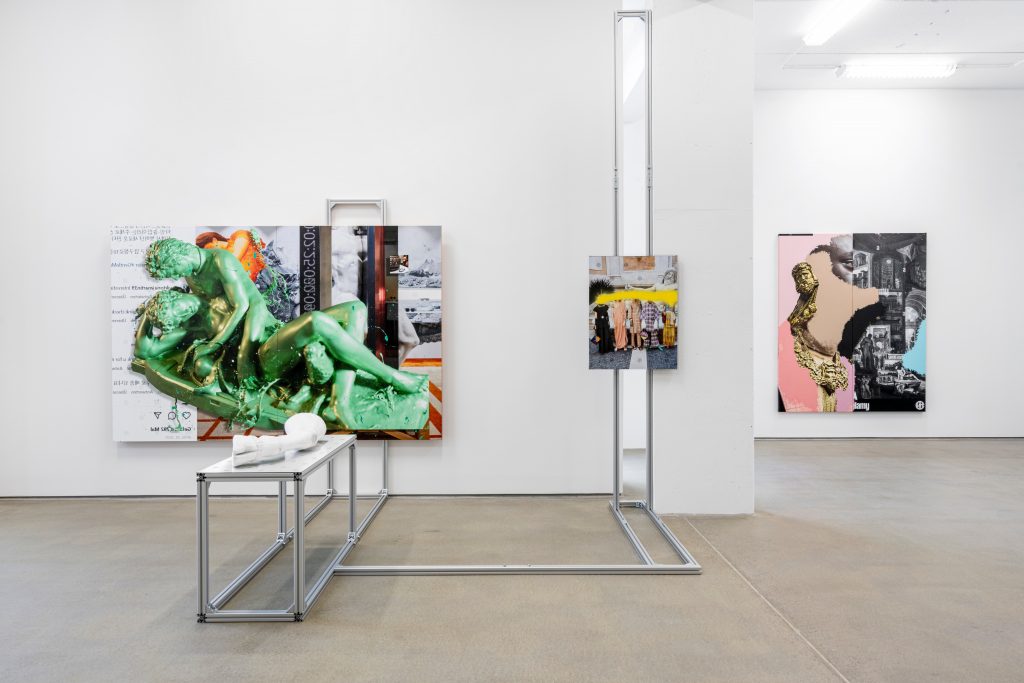
Appropriating the Appropriators
Christian systematically collects images from luxury brand campaigns. Gucci draping models in a room full of Roman statues? Louis Vuitton staging a campaign in the Louvre? He saves them, studies them, and then feeds them back into his own work, effectively reversing the cycle. “Companies use art to ennoble their products, making them appear more valuable. I reverse this process by bringing corporate visuals back into an artistic context.”
This extends beyond imagery. His previous exhibition Souvenir from Rome borrows its title from a Gucci campaign, mirroring how brands co-opt cultural heritage. “The advertising becomes a painting again. The product becomes an artwork again. I like that shift.”
The Illusion of Ownership
Holze exposes a contradiction in visual culture: an image watermark signals restriction until you pay to remove it, while a luxury brand logo increases desirability. One marks something as incomplete, the other as exclusive. “When you have the bag, the logo makes it more valuable. But with Getty Images, you just want the watermark gone even though the artwork was never theirs to begin with.”
Christian translates this tension into his own work. His paintings feature a faint, almost imperceptible pattern, his own “watermark.” It’s a subtle but deliberate gesture: a reminder that even in art, ownership is never as simple as it seems.

Provenance as a Living Process
Christian’s fascination with how artworks move through history is embedded in his practice. He studies pieces that have been endlessly copied and reinterpreted, like the Borghese Gladiator, one of the most duplicated sculptures in art history. “I wanted to go as far back as I could while staying within the ‘cliché’ of art history. The Borghese Gladiator became my starting point, it had already been copied and reshaped for centuries.”
This recursive chain continues with Bernini’s David, which was inspired by the same Gladiator. Christian taps into this long lineage of appropriation, questioning at what point an artwork stops being a copy and becomes something new.
Merging, Morphing, Multiplying
Christian Holze’s installation at Art Rotterdam is a living archive where historical references, digital manipulation, and material transformation converge. Set within a modular aluminum structure reminiscent of museum storage racks, his works actively expose the fluid nature of art history. “Seeing the back of an artwork often tells you as much as the front. It’s about history, context, and the journey of an object.”
At the core of the installation is a 3D-fused sculpture of two versions of Dionysus, one attributed to Michelangelo, the other by an unknown artist. By merging them into a single entity, Christian forces the copy to encounter itself, dissolving the boundaries between original and reproduction. “The copy is confronted with its own copy. They blend into each other, and suddenly, authorship becomes unclear.”
Another work draws from Jens Adolf Jerichau’s 19th-century sculpture Panther Hunter, a piece that mimics the idealised forms of Greek antiquity. Holze worked with an existing 3D model of the sculpture, compressing and reshaping it into a painting, reversing the usual process of sculptural replication. Even its title shifts: “I flipped the title, it’s now Hunter Panther. A small shift, but enough to create a new context.”
The final piece stems from Holze’s series The Most Boring Artist I Know, a nod to Cy Twombly’s obsession with Raphael’s School of Athens. After years of reinterpreting the fresco, Twombly ultimately dismissed Raphael as “boring.” Holze, however, sees something else. “I liked that, the idea that boredom can only come from deep engagement. It’s not ignorance, it’s the exhaustion of fascination.”
These works do not stand in isolation. They interlock like fragments of a shifting timeline, questioning how meaning is shaped through repetition, reinterpretation, and the constant movement of images across centuries.

The Work That Reflects Its Space
Even the rooms his works are created in play a role in their final form. Christian stages his sculptures in digital 3D spaces before translating them into the physical world. The catch? The rooms themselves disappear, only their reflections remain on the sculptures.
“The surrounding space creates the image. The reflections on the surface capture the environment, but once printed, the room itself disappears, only its echoes remain.”
This is a perfect metaphor for his entire practice. His work doesn’t provide fixed answers. Instead, it holds up a mirror to the systems we take for granted and lets us reconsider what we think we know. At Art Rotterdam, that mirror is right in front of us.
Written by Emily Van Driessen
The New Art Section at Art Rotterdam 2025, curated by Övül Ö. Durmuşoğlu, brings together a selection of international galleries, each presenting a solo exhibition of an artist exploring innovative formal and material expressions. Among them, GALERIST (Istanbul) hosts a solo booth by Yeşim Akdeniz (b. 1978, Turkey) whose practice seamlessly fits within this framework.
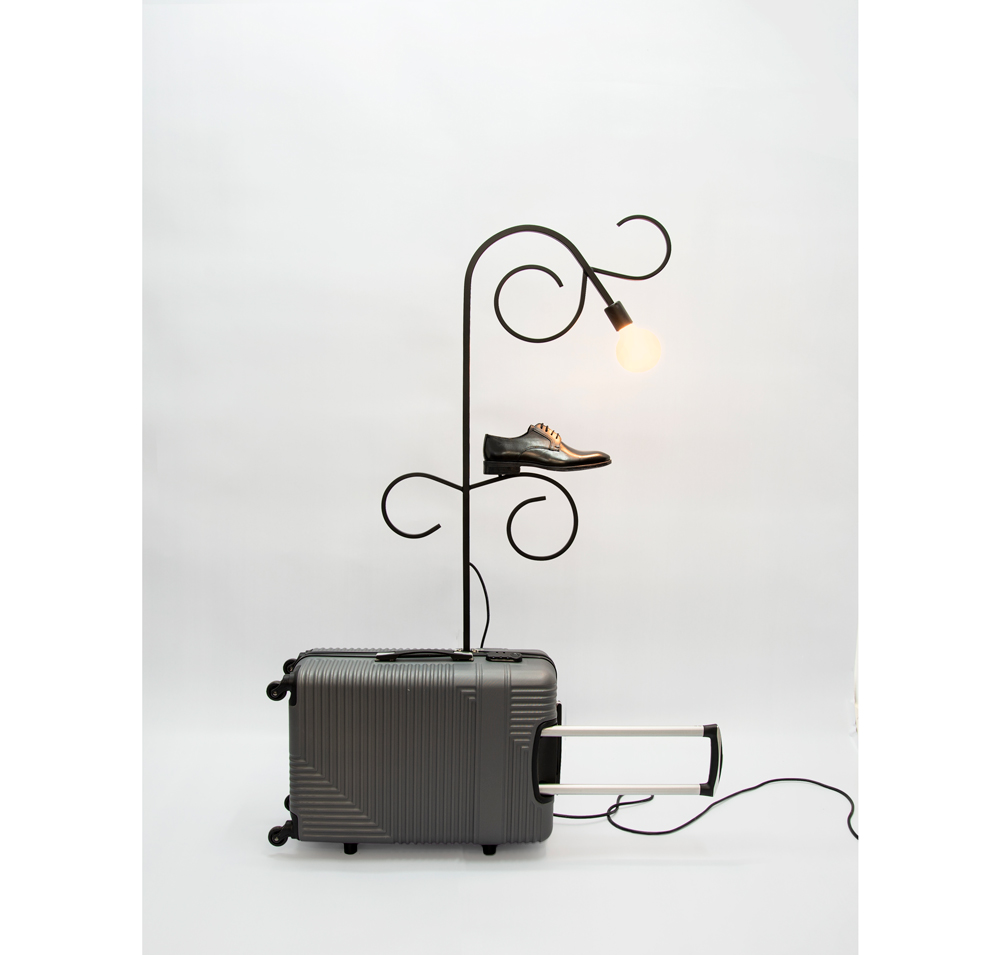
Yeşim Akdeniz investigates how objects carry narratives and challenges the assumption that objects are neutral. By assembling industrial remnants, mass-produced items, and hand-crafted elements, she reveals the hidden social histories embedded in materials. Yeşim plays with the tension between the unique and the serial, the handmade and the mass-produced, the personal and the political.
“Materials contain information,” she explains. “I work with mass-produced goods and industrial remnants, but within those objects are hidden stories about labour, supply chains, and migration. They are silent witnesses of larger systems.”
Nothing in her work is straightforward: a carpet is not a carpet, a lamp is not just a lamp, and a self-portrait is not a self-portrait.
Self-Portrait as an Orientalist Carpet: A Tapestry of Meanings
In her ongoing series Self-Portrait as an Orientalist Carpet, Yeşim uses textiles to question the shifting power dynamics between East and West. The works resemble traditional Anatolian blankets, a craft passed down through generations but increasingly displaced by industrial production.
” The traditional blankets are handmade, labour-intensive, and expensive. With the rise of mass-produced alternatives, this has become a disappearing tradition,” Yeşim explains.
Despite their familiar appearance, her pieces are not conventional carpets: they integrate industrial details such as zips, buckles, and chains, creating an unexpected tension between couture and domesticity. “I call them carpets, but they are not carpets. They are supposed to be self-portraits, but they are not self-portraits,” she says. ” I am interested in the area between categories. What we think we recognise shifts the moment we look closer.”
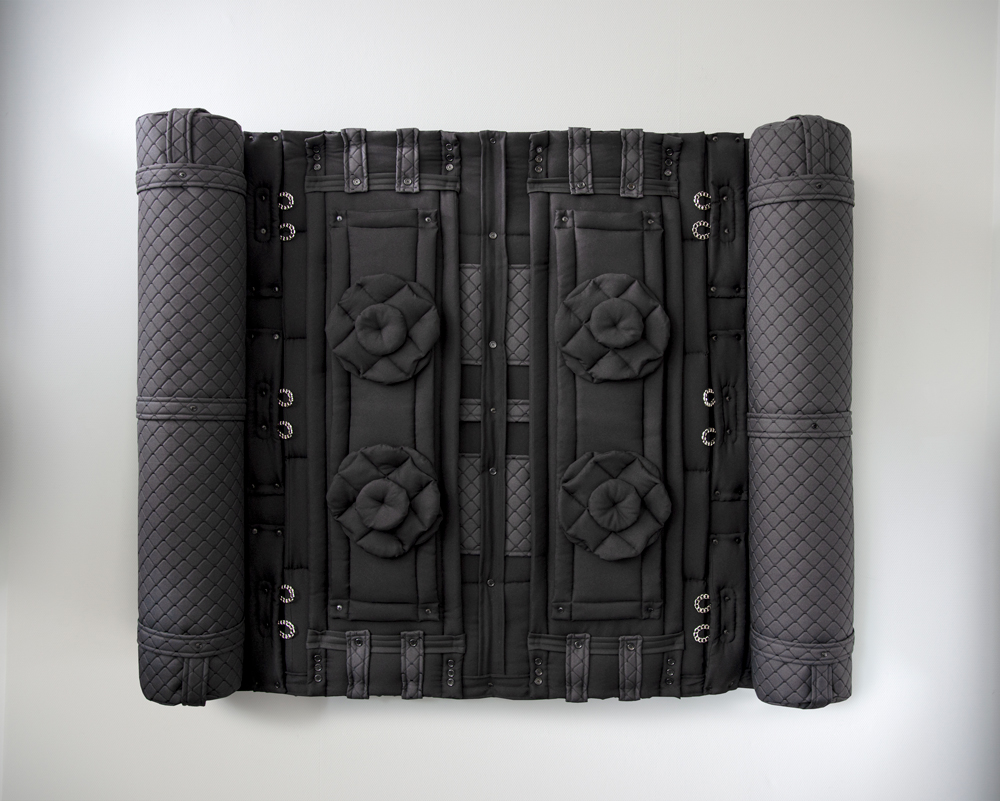
The series directly engages with Orientalism, a concept articulated by Edward Said, describing how the West has historically romanticised and oversimplified ‘Eastern’ cultures. Yeşim’s work reflects, distorts, and questions these portrayals.
“There is this idea that the East is one single entity, just ‘the Orient’. Obviously, the East is not a single entity; it consists of many different cultures, belief systems, and layers. This kind of oversimplification is what creates many stereotypes,” she notes. Her textile works embrace these contradictions, challenging fixed definitions of culture, identity, and authenticity.
New Faces in Town: Lamps as a Reflection of Migration and Mass Industry
Alongside her textile works, Yeşim presents a series of lamps, where mass production and mobility converge. These sculptural objects combine factory-made shoes with an iron structure, while their base consists of a suitcase. The result is a hybrid piece: a lamp that is equally an image of migration, production, and displacement.
“I wanted to create a mix of serial production and craftsmanship,” she says. “These lamps are exactly that. They contain shoes that are mass-produced in Istanbul, but the metal parts are welded by hand. They exist at the intersection of functionality and absurdity.”
By using a suitcase as the base, Yeşim makes a direct reference to movement, both in a literal and symbolic sense. “It was important to me that these objects have an invisible presence. As if the shoes have just been left behind by someone who moved on, as if the object itself have been travelling.”
Like her textile pieces, the lamps blur the lines between the serial and the handmade, between design and sculpture. They evoke themes of labour migration, economic survival, and the silent presence of workers whose stories often remain untold.

What Does “New” Mean in a Time of Change?
The New Art Section at Art Rotterdam 2025 poses the question: What does ‘new’ mean in a time of significant social and cultural transformation? Yeşim’s work offers a powerful response:
“What I do is not necessarily new in the sense of creating something completely ‘original’,” she says. “I look at what already exists, what moves, what disappears. The new lies in how you look at it again.”
In a world where labour, production, and migration shape both people and objects, Yeşim Akdeniz’s work exposes the instability of what we call ‘new’ as she repurposes, reconfigures, and reveals.
Written by Emily Van Driessen
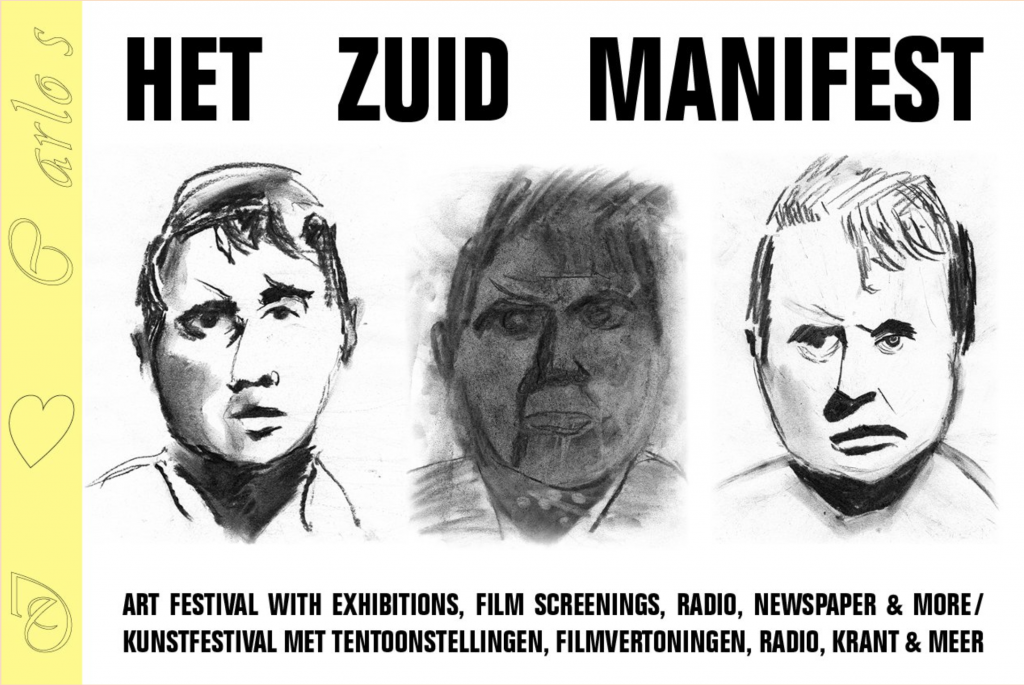
As part of Het Zuid Manifest: I Love Carlos, Rib is launching its own radio station together with residents and partners called The Last Terminal radio, which will be broadcast live from Intersections at Art Rotterdam from 27 to 30 March, daily between 11:00 and 19:00.
After 19:00 there will be a program of music, stories, and other contributions by artists such as Peter Fengler, Daniel Gustav Cramer, Michèle Matyn, Hedvig Koertz and Dieter Roth.
During the three days of the festival in Charlois, there will be artworks and performances to discover at various locations and you can participate in guided tours.
For the complete programming and participating artists: https://www.ribrib.nl/het-zuid-manifest
At Art Rotterdam, Stevenson presents an overview of work that Moshekwa Langa has created over the past 20 years, complemented by recent pieces. The South African artist’s work revolves around themes such as travel, belonging, displacement, memories, movement, and borders. Gallery owner Joost Bosland describes it as unique that so much work by an artist of Langa’s stature is still available. Next year, Langa will have a major exhibition at Melly that surveys his entire career.

That Moshekwa Langa addresses themes such as displacement, identity and inclusion/exclusion in his work is hardly surprising. These themes run like a thread through his life. Langa was born in 1975 in a place that did not officially exist. Bakenberg, a small village in northern South Africa, did not appear on any maps during Apartheid (1948–1994).
Bakenberg was part of Lebowa, one of ten so-called homelands whose maps only indicated the outer borders, while places within them were left blank. When Langa discovered this, it confused him, he says from his studio in central Amsterdam. So, it is no coincidence that fictional and incomplete maps frequently appear in his work.
His birthplace also plays a central role in his seminal work Where do I begin? from 2001. In the four-minute video, we see people boarding a bus along a dusty road from the perspective of a small child. Langa maintains a clear narrative: we see only a series of anonymous legs. Yet the images are rich in detail: a perfectly ironed pair of trousers next to worn-out shoes, a floral skirt, an umbrella, an overstuffed bag, stained clothes, a missing sock.
The phrase Where do I begin, taken from the song of the same name by Shirley Bassey, of which a fragment can be heard, suggests the start of a journey or a story. Combined with the repetitive movement, it reflects themes that frequently appear in Langa’s practice and life: travel, belonging, displacement, memory, identity, inclusion and exclusion, movement and borders. Where do I begin was acquired by Tate Modern in 2018.
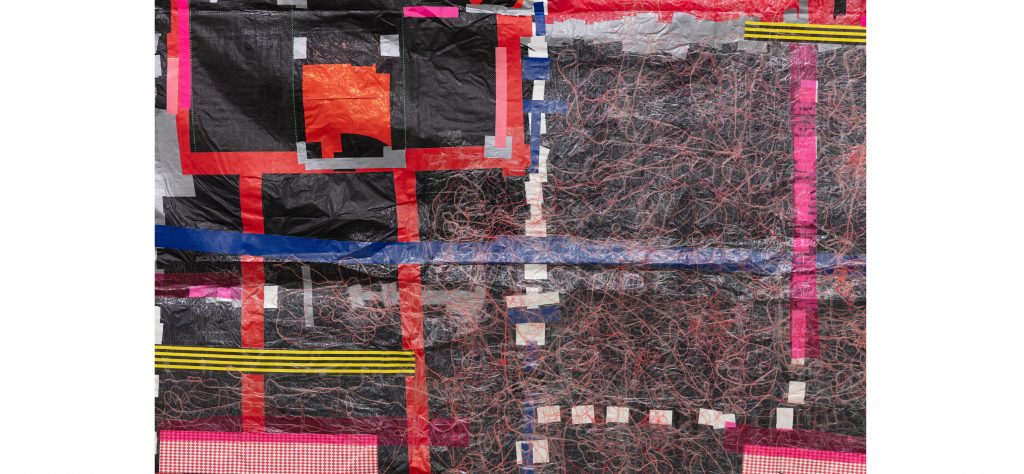
International recognition
Due to the themes Langa explores in his work, he has long been in the international spotlight. His work has been featured at the Venice Biennale (2003 and 2009) and São Paulo Biennale (1998 and 2010), as well as biennales in Johannesburg, Istanbul and Havana (all in 1997), Gwangju (2000) and Berlin (2018). It is also part of collections at institutions like MoMA in New York and MHKA in Antwerp. Langa has also exhibited at Fondation Louis Vuitton and Fondation Kadist in Paris, MAXXI in Rome, the New Museum and International Center of Photography in New York, Kunsthalle Bern and the Walker Art Center in Minneapolis. In the Netherlands, Langa has had exhibitions at Museum Boijmans Van Beuningen (1998) and in 2022, at The Hague’s KM21 with the telling title Omweg (Detour). Next year, Kunstinstituut Melly in Rotterdam will be joining this list. Despite this, Langa remains somewhat of an outsider in the Dutch art scene. “Who is this man who keeps showing up at openings?” asks Langa, jokingly downplaying his status.
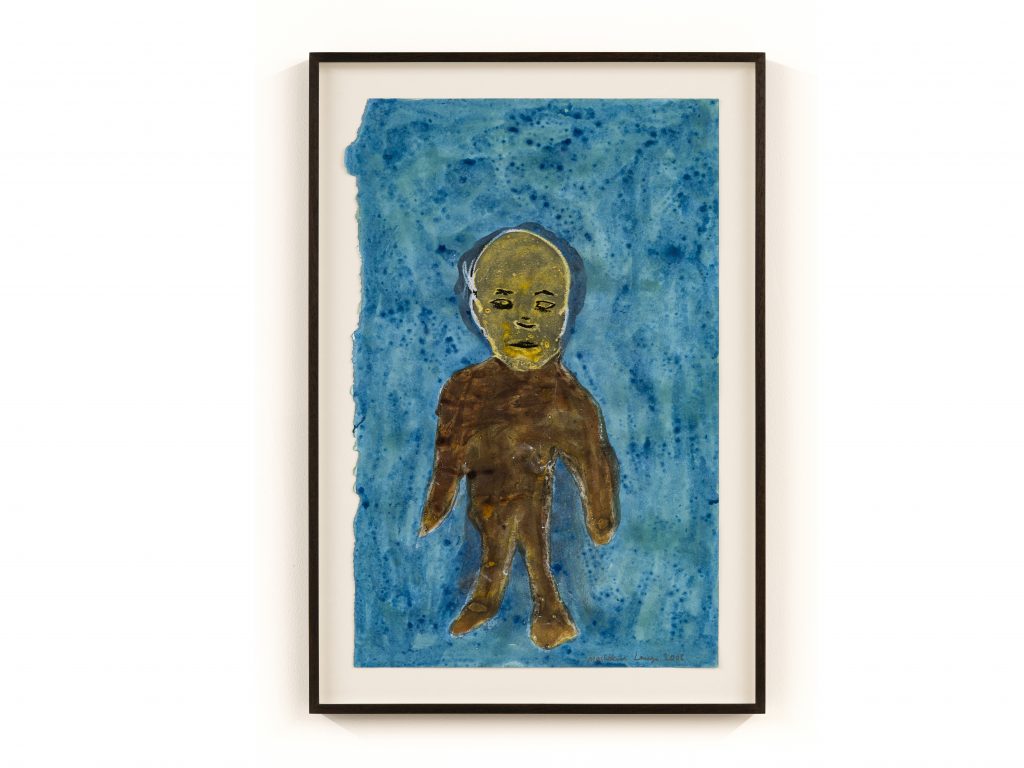
A game of chance and texture
In addition to videos, Langa also works in different types of media, from drawings to photography and from collages to installations. He enjoys experimenting with simple materials such as salt, coffee, receipts, bubble wrap, pigments, cigarette butts, tape, Vaseline, maps, bleach, advertisements, corrugated iron, lacquer, plastic and charcoal.
Most of his work is done on paper. He creates them on the floor of his studio by applying paint in puddles, which extends the drying time and allows room for chance. The texture of his typically abstract works is therefore often thick. Langa layers materials in much the same way he layers meaning in his work.
Langa first came to the Netherlands in 1997 to participate in the Rijksakademie residency programme in Amsterdam. He stood out with work that combined text, sculpture and sound recordings. He initially planned to stay for three more months, but ended up returning to South Africa only intermittently. He had changed and no longer fit into Bakenberg. Amsterdam became his base, though he frequently worked in Paris, Berlin and London.
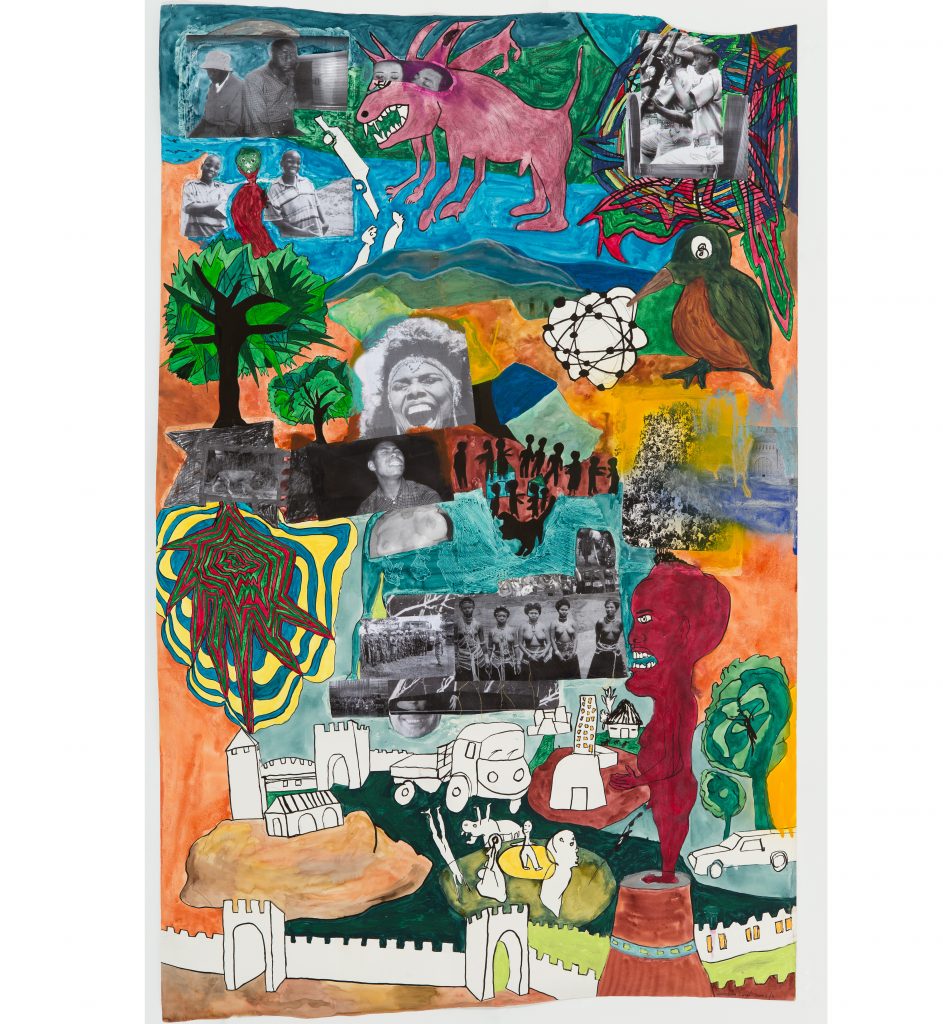
Missed rent
In 2017, Langa had two exhibitions in Paris, one at Fondation Louis Vuitton and the other at Fondation Kadist. He spent several months in the French capital setting up these exhibitions. This stay ultimately led to the loss of his Amsterdam studio—and with it, all the work he had created since first arriving in the Netherlands.
“I wasn’t earning much at the time, but what I always did was pay my rent in advance. For example, I would pay for the coming year, so I wouldn’t have to worry about it. Even when I left for Paris, I had paid in advance. But as it turned out, I had underpaid by one month. When I returned, I saw my entire studio in a container.” The container had been stored by Langa’s Belgian gallerists. Eventually, Stevenson managed to transfer the collection to Johannesburg. Gallery owner Bosland also recovered other lost work from Athens and London.
Now supplemented with new works, an initial selection from 1997–2017 is on display at Art Rotterdam in Stevenson’s booth. A Langa installation is also on view at the Kunstmuseum in The Hague as part of the New New Babylon: Visions for Another Tomorrow exhibition. It is the first Langa installation acquired by a Dutch museum. A broader overview of Langa’s work will follow in 2026 at Kunstinstituut Melly in Rotterdam.
Written by Wouter van den Eijkel
At Art Rotterdam’s Prospects section, Bianca Carague (b.1995, The Philippines) presents the sculpture, Ilog Maria Vessel (2023) and video Maria Islands (2023) from her immersive world Maria Islands (2023), a speculative future where the Philippines expands its territory using imported plastic waste. She creates immersive worlds that feel both serene and unsettling. Her work is dystopian in concept, yet visually soft and spiritual. “Even when I work with critical subjects, like climate change, power imbalance, or mental health, there’s always this softness in how I approach it. That’s just who I am,” she explains
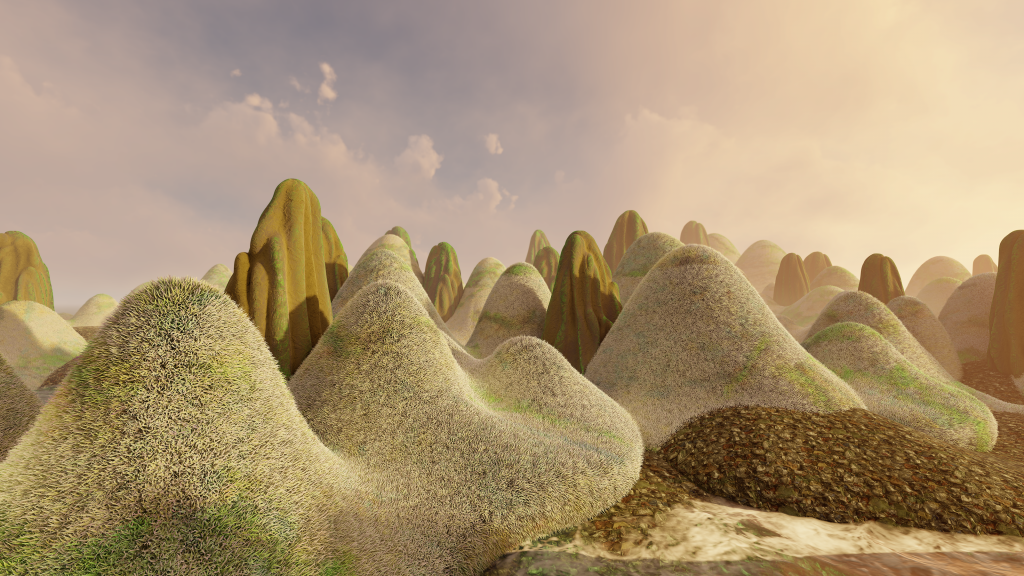
What is the common thread in your practice?
Bianca’s work spans different media – gaming environments, video, sculpture- yet the core remains the same: storytelling through immersive, speculative futures. Her artistic journey began in furniture and interior design in the Philippines, but her desire to create socially engaged work led her to study Social Design at Design Academy Eindhoven. “I started my Master’s thinking I’d be designing things that help people and solve problems. But I quickly realised design isn’t always about fixing things, it can also be about questioning and reshaping narratives,” she says.
Her early projects focused on digital storytelling and interactive environments, but over time, she also felt the urge to bring those fictional worlds into a more tangible, physical dimension. “I think starting with digital made me crave something physical. First, I wanted to touch things. Then, I wanted to smell them. I kept expanding beyond the screen.”
How did you start exploring digital worlds?
During the COVID-19 pandemic, as lockdowns pushed interactions online, Bianca became fascinated with gaming as a space for mental health, emotional care, and spiritual connection. “I had no business playing Minecraft,” she laughs. “But I thought, what if therapy could happen inside a video game? What would that even look like?”
What started as an experiment quickly grew into something much larger and now is a virtual landscape of 3M+ sqm. She built a Minecraft server, Bump Galaxy (2020-2023), for mental health where different environments emerged in response to conversations with players and professionals. “There is a meditation forest where you could plant a tree and watch it grow while meditating, an underwater temple for hypnotherapy, even a snowfield with floating questions about love and relationships.”
While the project began as a response to practical constraints and isolation, it ultimately reshaped the way Bianca thinks about how digital worlds can influence human experience, a perspective that continues to inform her work today.
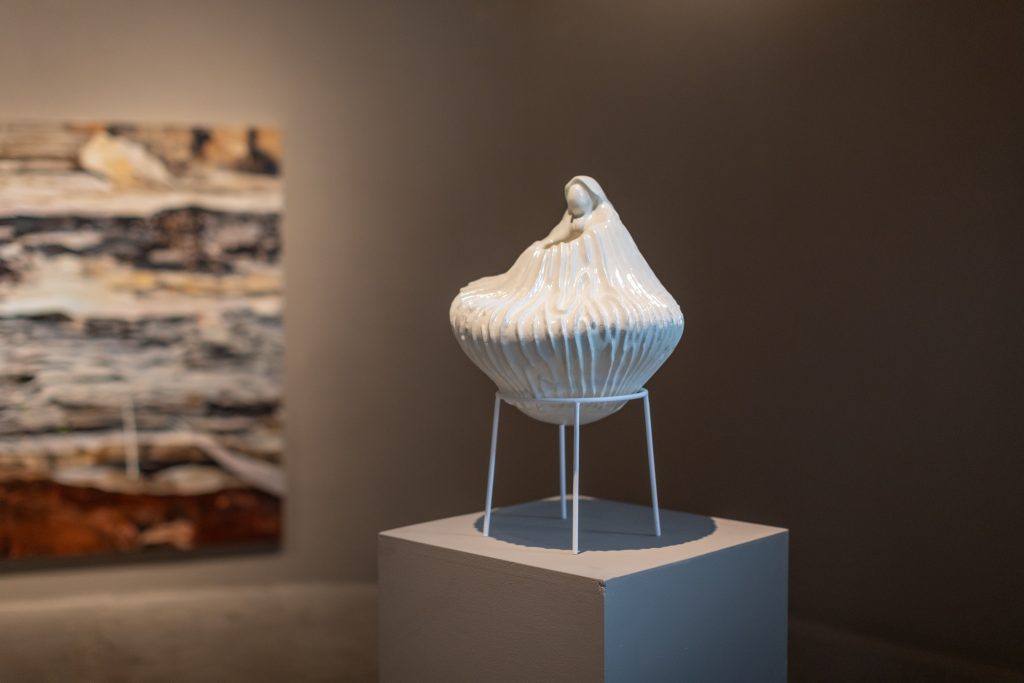
Your work is very participatory, not just in creation, but also in how it’s experienced. How do you approach that?
“I consider myself an introvert, but I love connecting with people through my work,” she says. Bianca’s work is constantly shaped by the people who interact with it. Whether through community-driven storytelling, gaming collaborations, or audience participation.
One of her participatory projects, Gen C: Children of 2050 (2022), invited young audiences to imagine future societies shaped by environmental change. Over three months, Bianca incorporated ideas from visitors into her work, evolving the exhibition through interactive workshops. In one session, participants entered a virtual simulation where they had to find creative ways to survive in an ocean full of plastic. Most of them immediately thought, ‘We could turn it into islands!’ That idea stuck with her and later became the foundation for Maria Islands. She first presented Maria Islands in 2023 at Nieuwe Instituut in Rotterdam.
When she decided to bring the project to the Philippines, it felt like a natural continuation, as it aligned with real issues the country struggles with. In Manila, she collaborated with fellow artist and studiomate Erik Peters, as well as other Filipino artists, to further develop its world and narrative in two more exhibitions
This participatory ethos extends beyond storytelling into multi-sensory experiences. “For Maria Islands, I also created a fragrance that mimicked what these plastic islands might smell like: ocean, salt, soil, burning tar, and artificial flowers. It was definitely interesting!,” she laughs.
Rather than simply observing, audiences become co-creators of the speculative futures she envisions. “Often, solutions are dictated from the top down. The people most affected by these issues rarely get a say in shaping their own futures. That’s where imagination becomes powerful.”
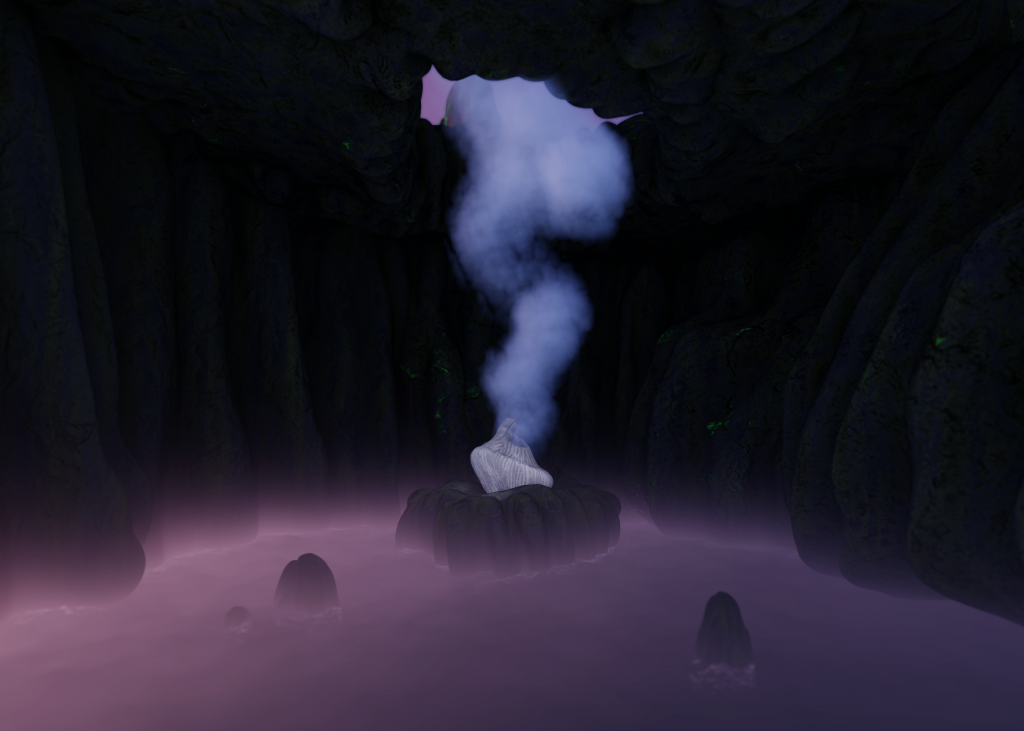
What will you be showing at Art Rotterdam?
At Prospects, Bianca presents a sculpture and a video from Maria Islands (2023), a project that reflects her personal connection between the Philippines and the Netherlands while addressing global power imbalances in waste distribution. “I’m from the Philippines, but I’ve spent years studying and working in the Netherlands. I wanted to create a project that resonates between these two places, not just personally, but in how they are connected through systems of consumption and waste.”
The video, Maria Islands (2023), speculates on a future where the Philippines expands its territory using imported plastic waste, referencing the real-world practice of Western nations offloading their waste onto the Global South. The Philippines, one of the largest recipients of plastic waste – much of it from the Netherlands – lacks the infrastructure to process the volumes it receives. “It makes no sense because, at the end of the day, waste doesn’t disappear, it becomes everyone’s problem. But in these global power structures, it’s the wealthier nations that get to dictate who bears that burden.”
Rather than simply exposing this imbalance, Maria Islands flips the power dynamic, imagining a future in a video where plastic becomes the foundation for nation-building. “What if, instead of being a symbol of environmental collapse, plastic waste became a resource? What if the Philippines, rather than being forced to absorb waste it can’t process, turned that into power, literally reshaping its territory, its economy, and its future?”
The sculpture, Ilog Maria Vessel (2023), brings this imagined world into physical form, allowing visitors to tangibly engage with her speculative landscape. The Mondrian Fund grant was instrumental in developing Maria Islands. “The grant gave me the opportunity to explore the geopolitical, cultural, and spiritual dimensions of what this speculative future could mean in greater depth.”
Written by Emily Van Driessen
With an uncertain gait, an elderly woman walks down stairs. She is holding onto the banister with her right hand. In the background, a text is shown in a language similar to German and Dutch, but which you cannot quite understand. The lady shuffles to the stage, turns to the empty hall and bows. For a few more seconds, there is silence, followed by music.
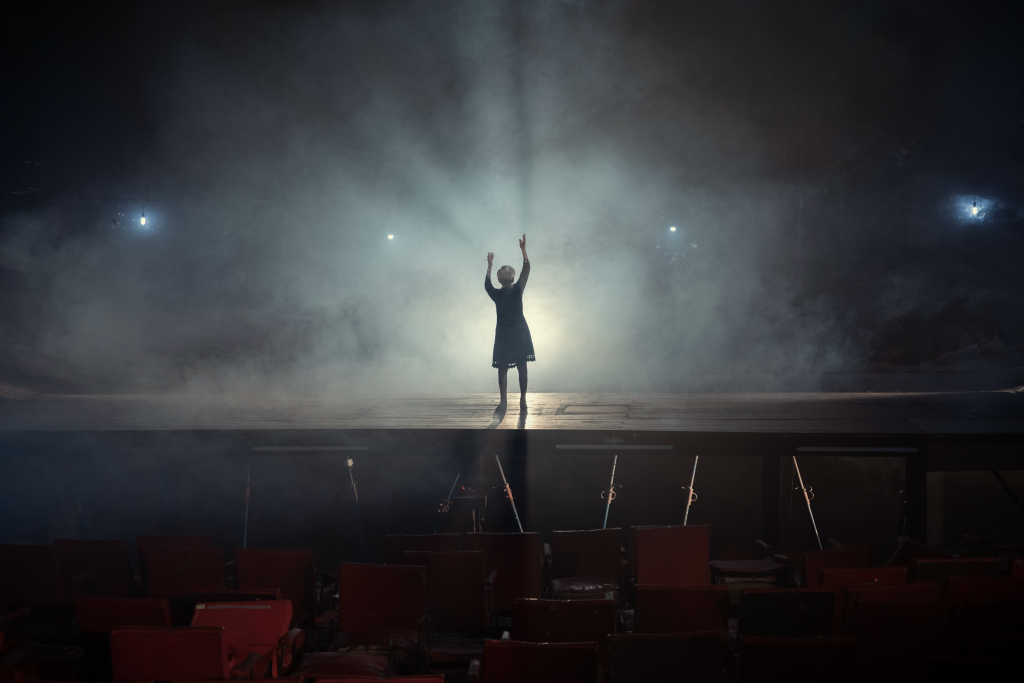
It is the opening scene of Mir Zaynen Do! (We are here!), a new film by Israeli artist Yael Bartana. The film, commissioned by Jewish art space Casa do Povo from São Paulo, Brazil, is on display at Art Rotterdam in the Projections section. A sculpture by Bartana is also on display in Sculpture Park and a solo show of Bartana’s work is on view at the Amsterdam gallery. The artist has been represented by Annet Gelink for more than 20 years. It is her seventh solo exhibition at the gallery and the first since 2020.
Yael Bartana represented Germany at last year’s Venice Biennale with an impressive installation in the German Pavilion as part of a duo presentation with Ersan Mondtag. Her presentation was complex and extensive, covering three rooms of the pavilion and marked by contrasts: optimism and pessimism, utopia and dystopia, sci-fi and age-old traditions.
In the first, green-lit room was a seven-meter-long scale model of a spaceship. The other rooms included the film Farewell, drawings and a 3D model of the spaceship. In those spaces, it became clear what the spaceship was referring to: offering visitors a way out from a world on the brink of ecological and political destruction somewhere in the near or not-so-distant future.
The press hailed the German pavilion as one of the highlights of the Biennale. The New York Times included it as one of the ‘8 Hits of the Venice Biennale’. Other leading publications mentioned the German pavilion among their highlights, including The Art Newspaper and ARTnews.
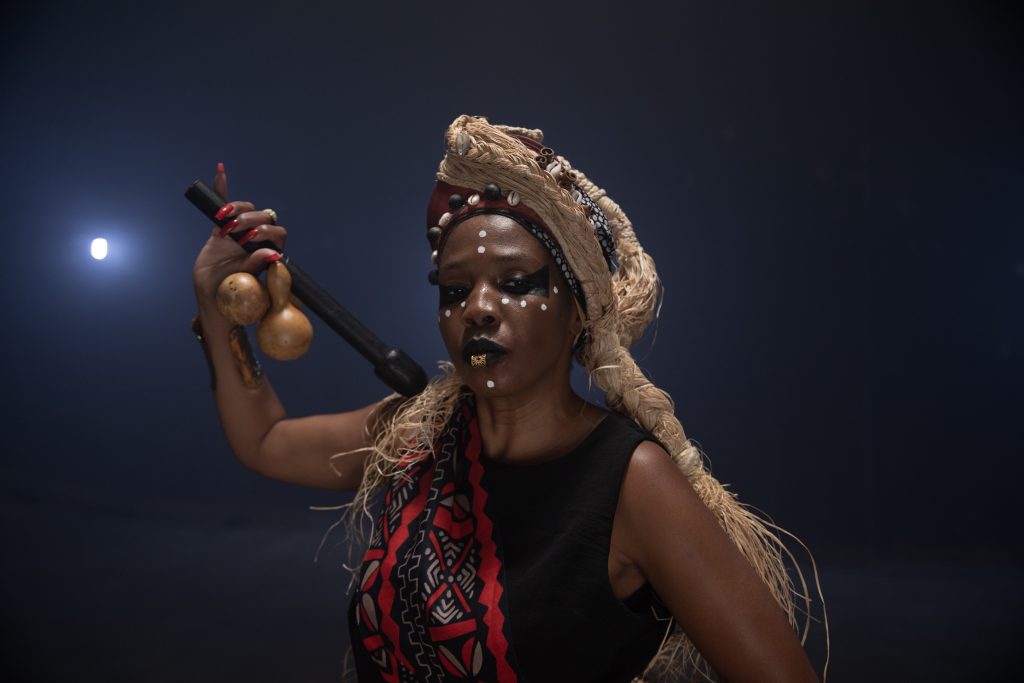
Yael Bartana (Israel, 1970) studied at the Bezalel Academy in Jerusalem and came to Amsterdam in 2001 to participate in the Rijksakademie residency programme. Her work has been exhibited at numerous locations around the world and is included in the collections of the Centre Pompidou, Guggenheim, MoMA, Tate and Walker Art Center in Minneapolis. In the Netherlands, her work has been acquired by the Stedelijk Museum Amsterdam, Kunstmuseum and Van Abbemuseum. Bartana lives and works in Amsterdam and Berlin. In her films, installations, photography and performances, she explores issues of national identity, trauma and displacement, often through ceremonies, memorials and public rituals.
Mir Zayen Do! is no exception. Many of these elements are covered in the 11 minutes of the film. For example, the language we hear is Yiddish and the theatre where it is filmed is Casa do Povo’s auditorium, which was one of the strongholds of resistance to Brazilian dictatorship in the 70s. The older lady – dressed in black with a pearl necklace – is the conductor of Coral Tradição, a Yiddish choir from Casa do Povo that has been singing lullabies and protest songs for decades.
After a few minutes, other people appear in the doorway: someone wearing a halo made of branches, a black man with a bare torso and long skirt and a woman who appears to be wearing a traditional West African robe. They are members of llú Obá De Min, a women-led Afro-Brazilian percussion group that plays music connected with their ancestry. They sit down in the dilapidated theatre seats.
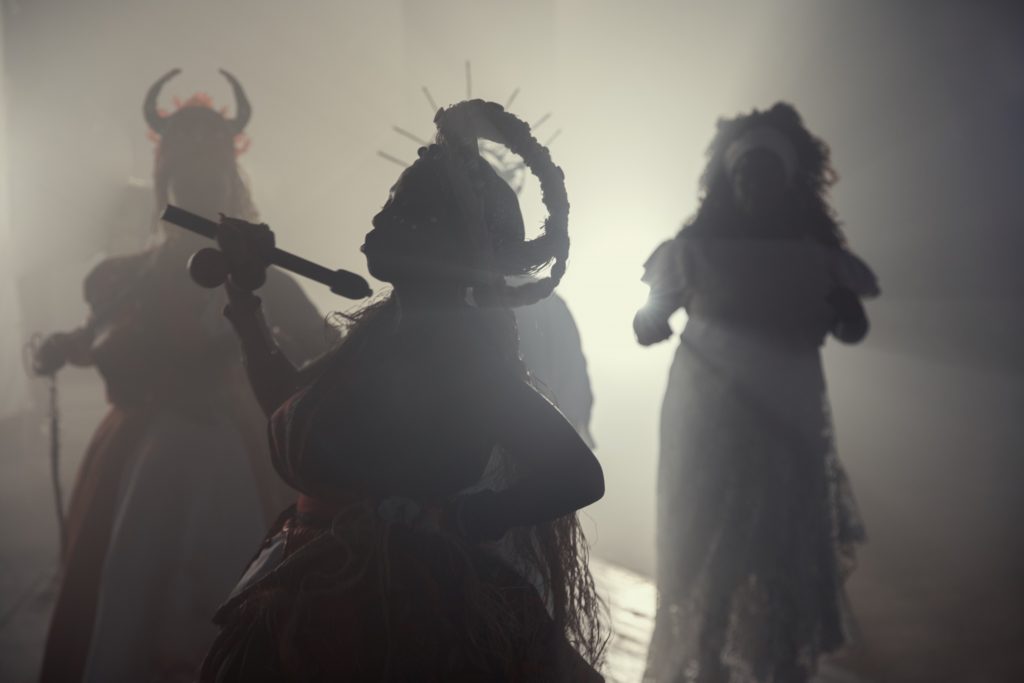
The film introduces us to two groups that share a common diasporic identity, even though we know they have very different histories and realities. They were both displaced (or forced to move from their home countries), but managed through collective singing and music to preserve their culture, beliefs and rituals to continue to survive.
The title is a direct quote from a Yiddish poem known as the Hymn of Partisans (Hirsch Glik, 1943). It can also be understood as an appeal to those left behind. But given how the film ends, this title can also be considered encouragement to develop new identities – on top of the old ones – in a relatively new environment. During the second half of the film, a hybrid of Ilú’s drumming and the choral singing of Coral Tradição is heard and the boundaries between the two are blurred.
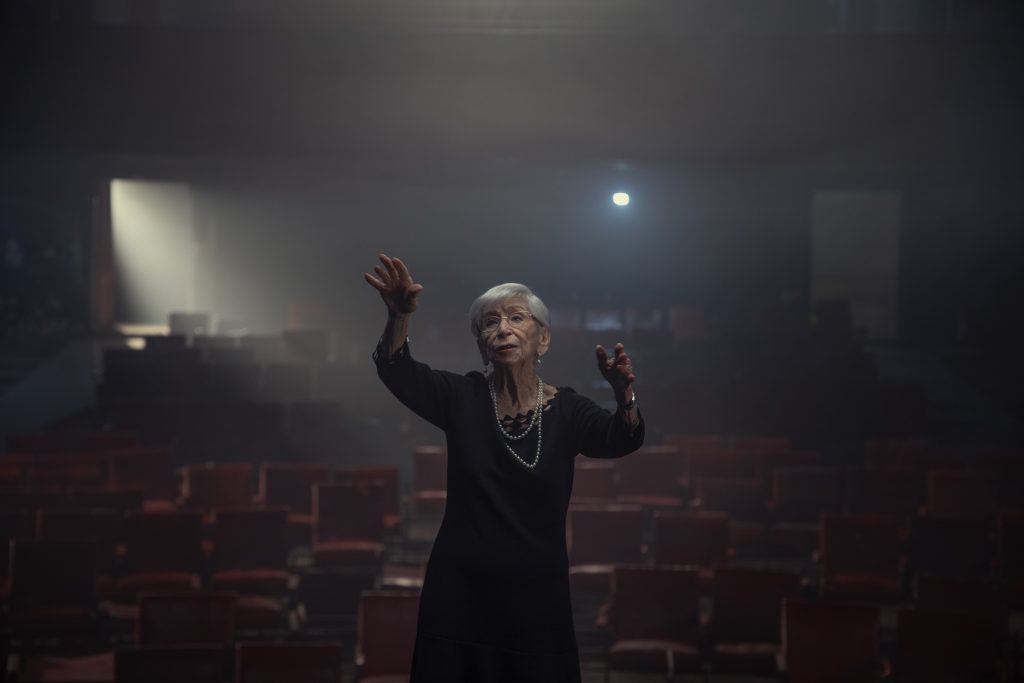
– Mir Zaynen Do! by Yael Bartana can be seen at Art Rotterdam from 27-30 March in the Projections section.
– The gallery exhibition will be on view from 15 March to 10 May at the Annet Gelink Gallery in Amsterdam.
Geschreven door Wouter van den Eijkel
During Art Rotterdam, from Friday, March 28 to Sunday, March 30, an extensive Talks and Lectures program will be launched: Reflections, filled with inspiring Artist Talks, Q&A sessions, and lectures on current topics, highlighted by artists, curators, museum directors, and other experts from the artistic field.
Reflections is part of Intersections and is free for visitors during the regular fair days.
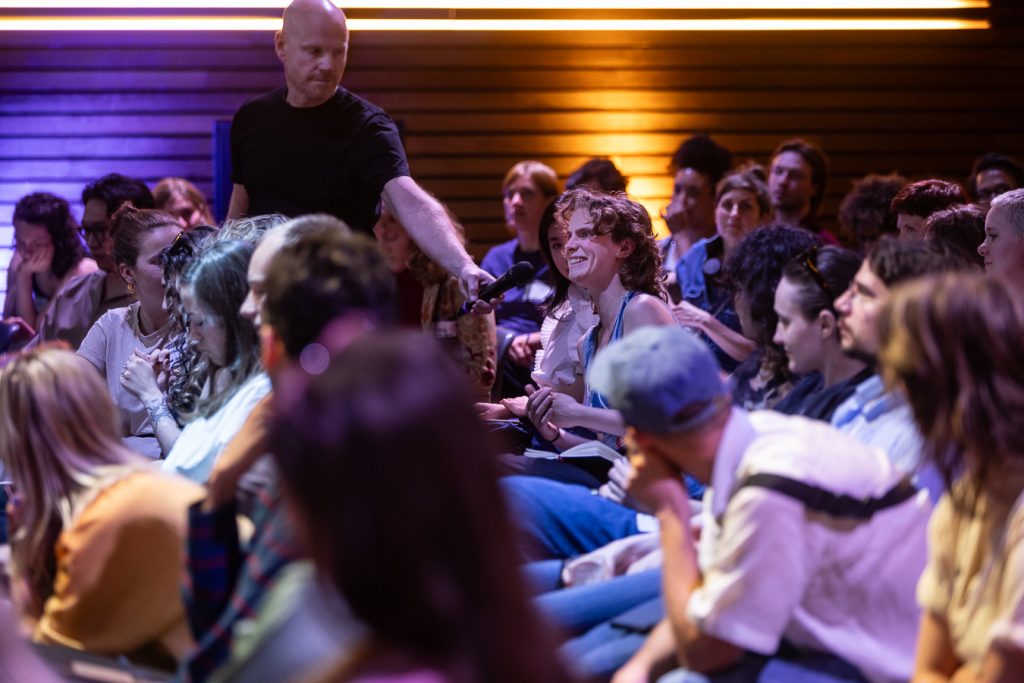
| 11:15 – 12:15 hrs | Dutch spoken Turning Points in the Artist’s Practice (hosted by: BK Informatie) Q&A with art historian Meta Knol and 3 artists: Tjebbe Beekman, Laurien Dumbar, and Diana Scherer | click here for more information |
| 12.30 – 13.15 hrs | English spoken Panel Discussion: Collector’s Initiatives to Support the Emerging Scene Panelists: Ronan Grossiat (ADIAF Prix Marcel Duchamp / ADIAF Emergence, Edouard Glissant Art Fund) | Benoît Doche de Laquintane (Co-Founder residence Solaris, Collection Benoît Doche de Laquintane) | Sarah Philp, Deputy Director, Delfina Foundation London Moderator: Liv Vaisberg, director Office for Art & Design, a Rotterdam based strategic office active in the fields of art and design | click here for more information |
| 13.30 – 14.15 hrs | English spoken Talk: THE HYBRID COUPLE, LIVING AND WORKING WITH AN AI HOLOGRAM | Annemartine van Kesteren, curator Boijmans Van Beuningen in conversation with artist Alicia Framis and her AI hologram Ailex | Courtesy: Upstream Gallery on show at Art Rotterdam, Main Section | click here for more information |
| 14.30 – 15.15 hrs | English spoken ‘Art in Dialogue – Creating Space: Institutional Practices and Cultural Shifts’ | Curator Fatoş Üstek and social architect Rubiah Balsem come together to explore new ways of reimagining the cultural landscape—championing curiosity, resilience, and cross-disciplinary collaboration to shape the future of the arts. Joined by international visual artist Narges Mohammadi and others, they will delve deeper into this subject | click here for more information |
| 15.30 – 16.15 hrs | English spoken If flowers could speak: monuments, memory, and politics of remembrance | Art historian Zippora Elders interviews artist Sarah van Sonsbeeck | click here for more information |
| 17.00 – 18.00 hrs | English Spoken Mondriaan Fund – Prospects | Get a Grant Event. Please register in advance: here | click here for more information |
| 11.30 – 12.15 hrs | Dutch spoken Good mom / Bad mom – Centraal Museum Utrecht Lecture curators: Laurie Cluitmans en Heske ten Cate | click here for more information |
| 12.30 – 13.15 hrs | English spoken Echoes of Us | Talk: Jeanthalou Haynes and Pedro Gil Farias | Moderator: Hannan Ouhlous | click here for more information |
| 13.30 – 14.15 hrs | English spoken New New Babylon: Visions for Another Tomorrow | Lecture by Margriet Schavemaker director of Kunstmuseum Den Haag | Saturday, March 29, 13:30 – 14:15 | click here for more information |
| 14.30 – 15.15 hrs | Dutch spoken Fenix, the first art museum about migration | Lecture by Museum director Anne Kremers (hosted by: Museumtijdschrift) | click here for more information |
| 15.30 -16.15 hrs | Dutch spoken Constant Flux: Joost Vandebrug’s journey of artistic and personal transformation. Director Bildhalle Christiane Hoefert in conversation with Joost Vandebrug | Courtesy: Bildhalle, on view at Art Rotterdam, Main Section | click here for more information |
| 16.30 – 17.15 hrs | Dutch spoken Art critic and writer Lucette ter Borg in conversation with visual artist Hans van der Ham | Courtesy: gallery KANT, on show at Art Rotterdam, Solo Duo | click here for more information |
| 17.30 – 18.15 hrs | English spoken Artist Talk Nemanja Nikolic | How Hollywood shaped socialism | Courtesy: Galerie Dix9, on show at Art Rotterdam, Projections | click here for more information |
| 11.30 – 12.15 hrs | Dutch spoken Our road to Santos | Talk Birgit Donker, director Nederlands Fotomuseum | click here for more information |
| 12.30 – 13.15 hrs | Dutch spoken FACE OFF – The confrontation between power and powerlessness. Artist Talk Bas Geerts, visual artist, music programmer and writer | Courtesy: MPV Gallery, on show at Art Rotterdam, Main Section | click here for more information |
| 13.30 – 14.15 hrs | English spoken Artist Talk Mercedes Azpilicueta | Material Stories: Time, Textiles, and Transformation | Courtesy: Prats Nogueras Blanchard, te zien op Art Rotterdam, New Art Section | click here for more information |
| 14.30 – 15.15 hrs | Dutch spoken Artist Talk Lisette Schumacher | Experience of space | Courtesy: Root Gallery, on show at Art Rotterdam, Main Section | click here for more information |
| 15.30 – 16.15 hrs | English spoken Artist Talk/Q&A & Book launch Elen Braga | Courtesy: MER Books & Wouters Gallery, Brussels, on show at Art Rotterdam, New Art Section | click here for more information |
| 16.30 – 17.15 hrs | English spoken Artist Talk Line Finderup | Gaming our reality | Courtesy: Albert Contemporary, on show at Art Rotterdam, New Art Section | click here for more information |
At Intersections during Art Rotterdam, Ellen de Bruijne PROJECTS presents Le Lente Passioni (2023) by Pauline Curnier Jardin (b. 1980, France). It’s a theatrical and immersive installation that dissects the spectacle of belief. Part confessional, part campsite, part domestic space, the work explores how Catholic rituals persist, evolve, and adapt – particularly when displaced into digital space.

For over 15 years, Pauline Curnier Jardin has built a practice shaped by theatricality, excess, and transformation, moving fluidly between film, performance, and installation. “It’s always been about what is staged and who is the spectator of that spectacle,” notes Sergi Rusca, gallery curator at Ellen de Bruijne PROJECTS. Born in Southern France and having lived in Italy for many years, her work is infused with the ritualistic intensity of Catholicism, the theatricality of devotion, and the ways in which faith is both deeply personal and inherently performative.
For Le Lente Passioni, Pauline assembled video footage from ethnomusicologists’ archives, capturing Easter processions across Catholic Europe. These rituals were forced onto screens during the first Italian lockdown. Worshippers, unable to gather, adapted: kneeling before televisions, singing alone in their homes, sharing recordings online. These images of faith, fragmented yet enduring, show how devotion is mediated through technology, while still demanding bodily endurance and presence.
Women in Rituals
Curnier Jardin has long been drawn to female archetypes, particularly those at the intersection of power, devotion, and marginalisation: the nun, the virgin, the witch. These figures, deeply embedded in pagan mythology and Christian iconography, have been both revered and feared, often as a means of controlling the female body.
“You see this synchronism of references in her work,” says Rusca. “Pagan elements merge with Christian icons, creating these out-of-this-world characters that sit between the divine and the profane.” Her work revisits these figures, the saint, the martyr, the accused witch, to see how their narratives can be retold, and how they can break out of the roles assigned to them.
This interest in the female body’s suffering and devotion is particularly visible in Fat to Ashes (2019), an earlier work in which Pauline intertwined three ritualistic events: a Catholic festival honouring Saint Agatha, the slaughter of a pig, and Cologne’s Carnival. “Saints are venerated through their pain, Saint Lucia, whose eyes were removed; Saint Agatha, whose breasts were cut off.” In Sicily, Agatha is still remembered through the ritual consumption of breast-shaped pastries.
These acts – sacrifice, transformation, and excess – connect bodily endurance, ritualistic repetition, and the boundaries between the sacred and the grotesque. Le Lente Passioni continues this inquiry, shifting the focus from physical rites to their fragmented digital afterlives, where devotion persists even when bodies are absent.
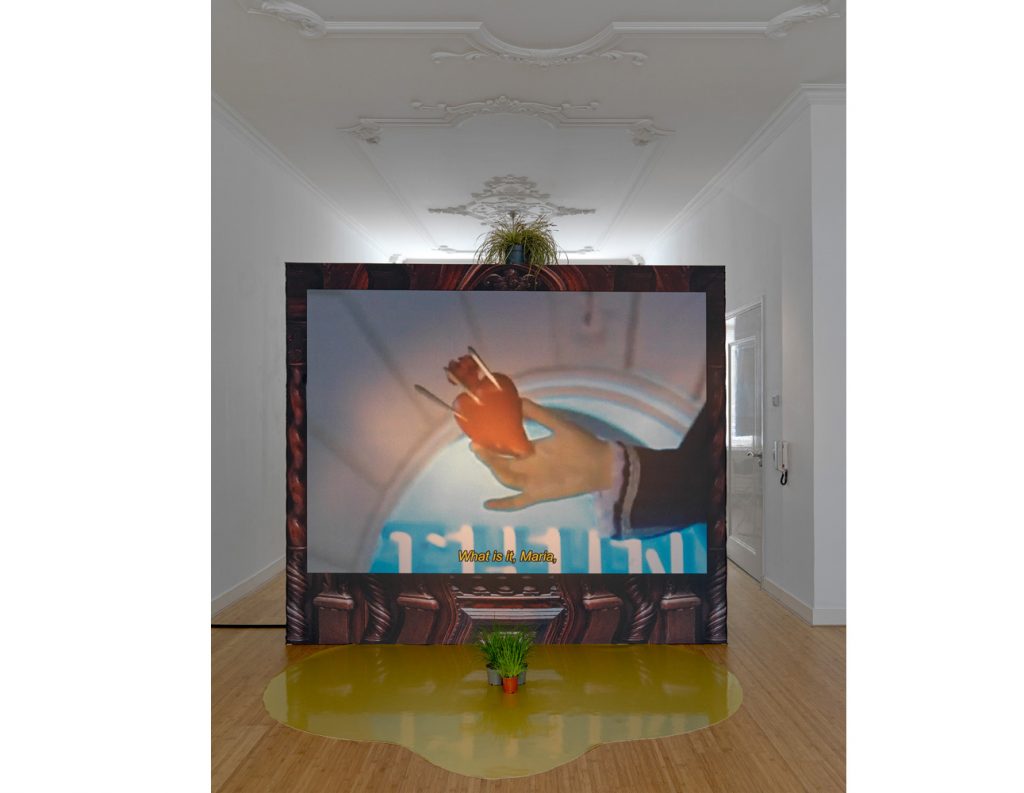
Flesh and Faith
“Christian imagery constantly returns to the aching body, the wounded flesh,” Rusca explains. Catholicism is a faith of the body, where martyrdom and devotion trough pain are integral to its rituals. This is not just theological but theatrical; the blood, the wounds, the endurance of the flesh are spectacles in themselves.
In Le Lente Passioni, these elements manifest in bodies crawling on their knees, rhythmic chanting, and the visceral presence of suffering. “Even in digital form, these rituals still involve endurance, still demand something of the body,” notes Rusca.
The installation itself echoes this tension between intimacy and spectacle. The pierced heart-shaped confessional window disrupts the traditional division between priest and believer, observer and participant. The heart at the centre of the installation reinforces the tripartite and is a direct reference to Christ’s crucifixion.
Triptych Structure: Confessional, Campsite, Domestic Space
Le Lente Passioni’s tripartite structure reflects Christian numerology. “The number three is crucial in Christianity,” says Rusca. “The Holy Trinity, the three days between death and resurrection, even the medieval belief in three nails used to crucify Christ.”
In Le Lente Passioni, this sacred structure is reinterpreted. At the front, the installation resembles a campsite, a space where absurdity collides with the weight of the religious imagery inside. Moving inward, a confessional window with a baroque altar print opens onto a television screen, where devotion plays out on-screen. At its core, a glowing TV replaces the altar, reflecting the replacement of physical rituals with digital participation.
Within the film itself, this layering continues. “Inside the video, it’s a TV within a TV,” Rusca notes, referring to believers watching mass online, their faith refracted through screens. The installation asks: what happens when faith is displaced? How does it endure when stripped of its collective, embodied experience?
The wounded heart, a site of devotion and suffering, endures, even as the rituals around it shift.
Written by Emily Van Driessen
For the ninth consecutive year, the NN Art Award will be presented in 2025 to a promising artist showcasing their work at Art Rotterdam. This year’s nominees are Diana Scherer (andriesse eyck galerie), Marcos Kueh (Prospects section of the Mondriaan Fund, courtesy of Galerie Ron Mandos), Pris Roos (Mini Galerie) and Bodil Ouédraogo (Prospects section of the Mondriaan Fund). The work of the four nominees will be on view at Kunsthal Rotterdam from 15 March until 11 May 2025.
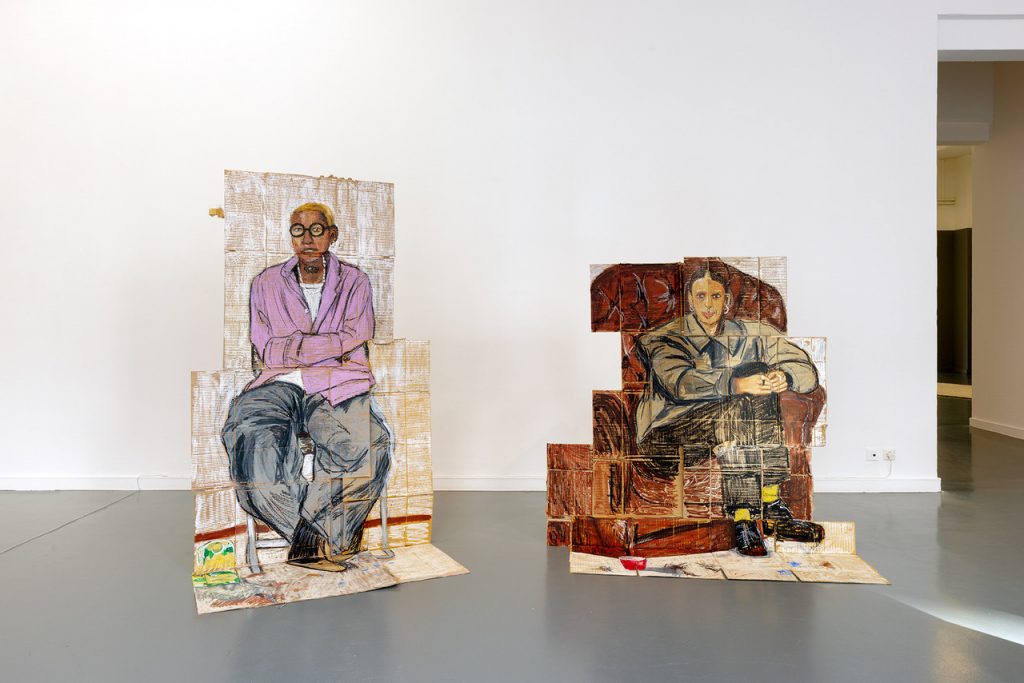
Pris Roos (1984) is a multidisciplinary artist, researcher and storyteller. Her practice moves between painting, spoken word, video, performance and installation. She explores themes like identity — including her own lived experience as a queer woman with a bicultural background — migration, (chosen) family and memory. Weaving together personal narratives with those of others, she amplifies voices of people who, like herself, navigate multiple cultures and identities. In doing so, her work forms a bridge between individual histories and a shared collective memory.
A key source of inspiration is her childhood spent in her family’s toko, a small Indonesian grocery store run by her relatives who emigrated from Indonesia to the Netherlands. For Roos, the toko is more than just a store; it is a piece of Indonesian heritage, a meeting place where different cultures converge, and where scents and colours blend. To this day, she regularly helps out in the store, both to support her parents and to remain connected to these communities. This notion of shared stories and social networks is a recurring theme in her work, where close observation and deep listening skills become essential tools. Roos works with remarkable intimacy, which is particularly striking given that she finds it more difficult to have these kinds of conversations with her own parents, who rarely speak about their family history.
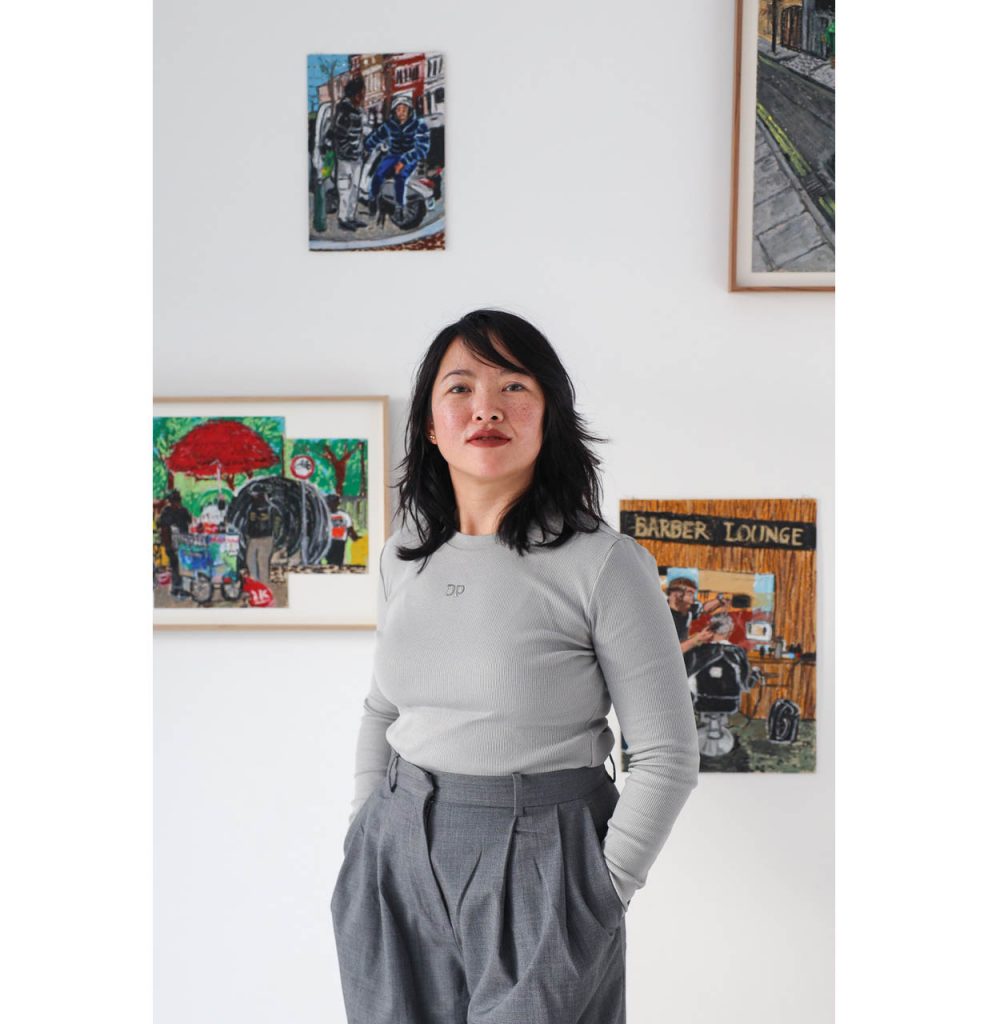
Roos’ work is deeply social and narrative-driven. Her portraits and installations are not distant or detached; they are intimate reflections of the people she encounters. She frequently works with everyday materials such as cardboard, brown canvas and kraft paper, layering them in ways that lend her work a raw, textured quality, echoing the dynamic nature of the stories she tells. She combines traditional techniques with elements of street culture, pop culture and activism. Spoken word and sound also play a role in her installations, which brings them alive in a vivid way.
Can you tell us more about the work you are presenting at Art Rotterdam and Kunsthal?
The works I am presenting at Art Rotterdam and Kunsthal explore representation, gathering and everyday life. At Kunsthal, I will showcase large-scale cardboard installations depicting people in their own living spaces — individuals the audience may not know but whom I have come to know intimately through conversations and regular meetings. Together, we spoke about family, identity and key moments in their lives. To me, they are role models, the unsung heroes of the world. At Art Rotterdam, in Mini Galerie’s booth, I will present smaller works featuring various street scenes. The street has always felt like home to me — a space where so many different people come together. It reflects the everyday. In that sense, my work is quite direct and straightforward.
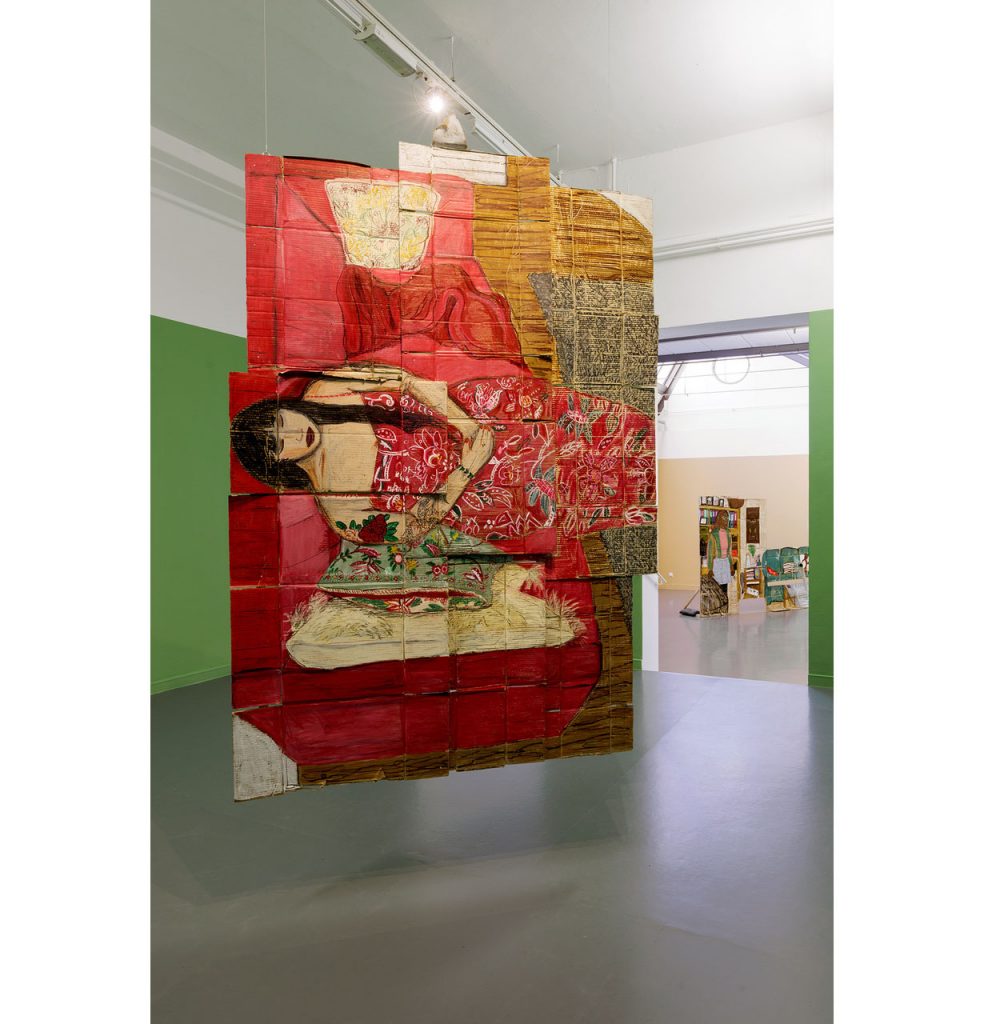
What are your plans for 2025?
In 2025, I plan to create my own picture book about my parents’ toko. [This year, Roos’ first children’s book PRIS – De Toko will be published by Uitgeverij de Harmonie, ed]. The story follows my mother, who suddenly disappears from the toko, prompting a search for her through a fantasy world in which the shop is transformed. The illustrations depict products from the store, such as yardlong beans, turmeric and bami soup. My work is often rooted in portraiture and my surroundings, but this time I am embracing imagination and constructing my own worlds, which feels both exciting and challenging. I also want to create life-sized installations based on these illustrations and develop an accompanying exhibition. Additionally, I have exhibitions planned in Zaandam and Paris, a visit to the Liverpool Biennial, and I will also take some time to rest.
How did you feel when you heard you were nominated for the NN Art Award?
I was surprised and honoured to be nominated alongside such incredible artists.
If you won the award, what project would you pursue immediately?
With the prize money, I would further explore my family history. Like many children of immigrants, I am deeply interested in my family’s background and stories, but these are rarely spoken about. This would be an opportunity to delve deeper into that history and discover it, along with father. I would travel across Java, observing people and street scenes, engaging in conversations, and creating portraits — in the country that carries the history of my ancestors.
Pris Roos earned her Bachelor of Fine Arts from the Royal Academy of Art in The Hague, including an exchange programme in Bremen, and completed her Master’s degree at the Hochschule für bildende Künste in Hamburg. In 2020, she was appointed City Illustrator of Rotterdam. Her work is part of the collections of Stedelijk Museum Schiedam, the Dutch Government, and the Rotterdam City Archives. From 21 February until 11 May, her work will be featured in the exhibition ‘Collective Joy – Learning Flamboyance!’ at the prestigious Palais de Tokyo in Paris. Previously, she has exhibited at institutions such as Kunsthal Rotterdam, the Van Abbemuseum, TENT Rotterdam, Framer Framed, MAMA Rotterdam and the Amsterdam Museum.
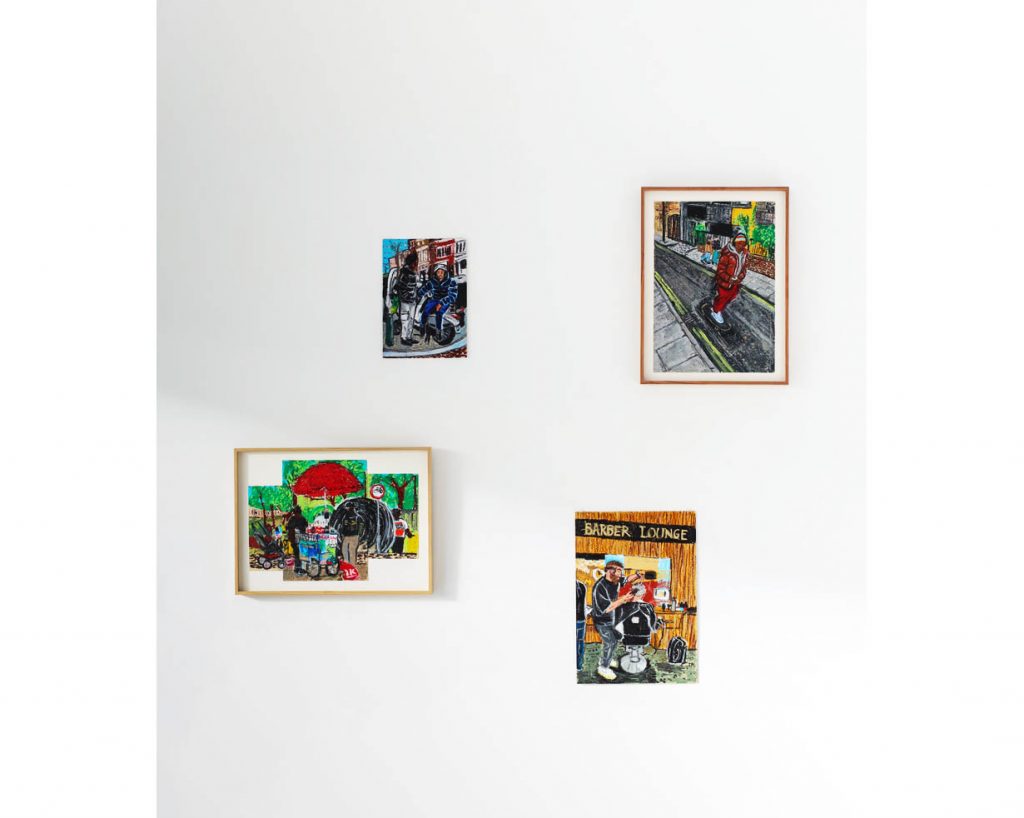
Beyond her artistic practice, Roos is also active as a curator, activist and educator. She initiates art projects that connect communities and engages young people in her work, encouraging them to reflect on their own position and identity. Together with Hannah Jacques, she founded a travelling children’s library that has been stationed at various locations in Rotterdam and The Hague. This library is filled with books and graphic novels that allow children to see themselves reflected in stories. This book collection features works on topics such as identity, gender, sexuality and climate — offering an important alternative to the predominantly white and heteronormative perspectives children are often exposed to. This not only provides them with more choice but also fosters greater awareness of themselves and the world around them.
The winner of the NN Art Award 2025 will be announced on Friday 28 March at 20:00 in Kunsthal Rotterdam. During this celebratory evening, all exhibitions, including the NN Art Award exhibition, will be freely accessible to attending guests.
Written by Flor Linckens